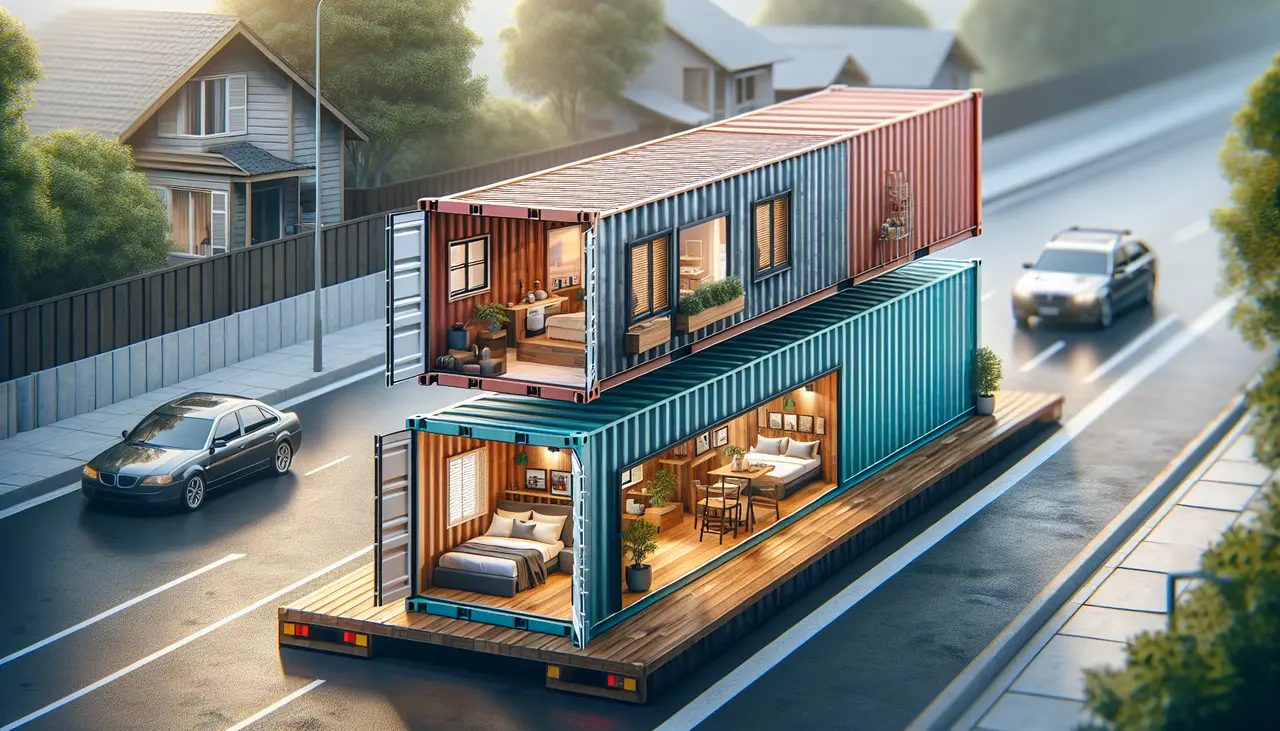Introduction to Shipping Container Homes
Shipping container homes are a smart, eco-friendly choice for housing. These homes are created out of recycled shipping containers. Picture this: sturdy steel boxes transformed into compact, modern living spaces. Why go for them? For starters, they are cost-effective. Building a traditional home costs way more than setting up a container home. Plus, they’re flexible. You can stack them or spread them out to fit your design vision. Also, they’re fast to construct compared to regular homes. You’d be cutting down on both time and the environmental footprint.
Another cool point is the customization aspect. Want a loft-style studio or a multi-story family home? Shipping containers can be modified to make your dream home a reality. In summary, shipping container homes offer a mix of affordability, flexibility, sustainability, and speed of construction, making them an increasingly popular choice for innovative living spaces.
The Appeal of Shipping Container Homes
People are turning heads towards shipping container homes for good reasons. First off, they’re economical. Imagine cutting down building costs significantly because you’re starting with a pre-built frame. Then, there’s the eco-friendly angle. Reusing these massive steel boxes gives them a new life, keeping them out of landfills. Plus, many appreciate the simplicity and minimalism a container home offers.
These homes push boundaries, showing a smaller, well-designed space can be just as comfortable and appealing as a large house. Another cool factor? The design possibilities are limitless. From single, tiny homes to expansive, multi-container estates, you can customize a shipping container to match any style or need. Lastly, these homes can be incredibly durable and weather-resistant, making them a smart choice for those looking to tread lightly on the planet while living in a modern, sturdy home.
Planning and Designing Your Container Home
To start building your dream home from shipping containers, planning and designing are key steps you can’t skip. First, you need to decide on the size of your home. How many containers will you use? One for a cozy studio or several for a spacious multi-room house?
It helps to sketch out a rough layout or even get professional design services to visualize your idea. Next, think about the placement of windows and doors. They’re not just about light and access; they also define the flow of your space. Remember, cutting too many openings can weaken the structure of a container.
Also, consider insulation and climate control. These steel boxes can get very hot or cold, depending on the weather. Choosing the right insulation method is crucial for comfort. Finally, check your local building codes and permits. Every area has its own rules for construction, and container homes are no exception. So, the bottom line: plan well, design with care, and you’ll be on your way to creating an innovative home that stands out.
Legal Considerations and Permissions
Before diving into transforming a shipping container into your dream home, there’s legal stuff you’ve got to sort out. First things first, you can’t just plop a container anywhere and call it a day. Different places have different rules. You need to check with your local planning office about zoning laws, building codes, and what permits you need. This step is crucial. You might find some areas are cool with container homes, while others have strict restrictions.
Also, think about utilities like water, electricity, and sewer lines. Getting these hooked up means dealing with more rules and maybe more permits. Don’t forget to ask if there are specific standards for container homes in your area. Some places want all homes, container or not, to meet certain energy efficiency or safety standards. Skipping this part can lead to fines or being told to tear down your new home. So, take this seriously and get all your legal ducks in a row before you start building. Trust me, it’s way less of a headache to do it right from the start.
Insulation and Climate Control Techniques
To turn a metal box into a cozy home, getting the insulation and climate control right is key. Think simple but effective. Start with insulation. Spray foam is a top pick because it seals tight spaces and acts as a barrier against heat and cold. Another option is panel insulation – easy to install and good for keeping your container snug. Now, let’s talk climate control.
A mini-split system is your best bet. It heats and cools, without taking up too much space. If you’re in a sunny spot, consider solar panels. They can power your climate control, making your container home both eco-friendly and wallet-friendly. Remember, it’s all about keeping your cool in summer and staying warm in the winter, without breaking the bank.
Plumbing, Electrical, and Structural Modifications
Turning a shipping container into a home is a cool project, but it’s not just about stacking them and cutting out windows. You’ve got to think about the guts of the place – plumbing, wiring, and making sure it doesn’t fall apart. So, here’s the rundown. First up, plumbing. It’s like the veins of your home, carrying water where it’s needed.
You have to plan where your bathroom and kitchen will be, and get pipes installed. This isn’t a place to cut corners; bad plumbing equals big problems later. Now, onto the electrical stuff – the nerves of your home. Wiring a container home can be tricky because you’ve got to make sure you have enough power for your needs without overloading the system. You’ll likely need a pro to figure out the best way to set up your electrical panels, lights, and outlets. Finally, let’s talk about keeping it all standing.
Shipping containers are tough, but once you start cutting holes for doors and windows, you’re messing with their strength. You’ll probably need to add some extra steel beams to keep everything sturdy. These modifications make sure your container home is safe, comfortable, and up to code. So before you dive into building, make sure you’ve got a solid plan for these essentials.
Interior Design Ideas for Container Homes
Creative use of space is key when designing the interior of a container home. These homes offer a unique canvas for personalization, merging industrial charm with modern living. Open floor plans work best, enhancing the sense of space inside. Large windows not only bring in ample natural light but also create an illusion of a larger interior.
Consider multi-functional furniture—a sofa that turns into a bed or tables that fold away when not in use optimizes space. For a personal touch, add vibrant color accents on walls or through furniture to break the industrial monotony. Mirrors strategically placed can also make rooms appear bigger. Don’t shy away from vertical gardens or hanging plants for a fresh, lively aesthetic. Remember, the goal is to blend functionality with your personal style to make your container home truly yours.
Sustainability and Eco-Friendly Benefits
Turning shipping containers into homes is a clever way to reuse these big metal boxes. It’s not just trendy; it’s good for the planet. First off, you’re recycling something that would otherwise take up space. Each container you reuse saves about 3,500kg of steel, reducing the need to produce new materials. Plus, these homes leave a smaller carbon footprint.
They often need less energy to heat and cool, thanks to their smaller size compared to traditional homes. Adding insulation makes them even more energy-efficient. Also, because of their modular design, it’s easy to include eco-friendly technologies like solar panels or rainwater harvesting systems. By choosing a shipping container home, you’re not just getting a unique living space. You’re making a statement about valuing sustainability and reducing waste.
Cost Analysis and Budget Planning
Transforming a shipping container into a home is an innovative and eco-friendly idea, but before diving in, it’s crucial to understand the costs involved. The price for a used shipping container can range from (1,400 to )4,500, depending on size and condition. Remember, this is just the starting point. After acquiring the container, converting it into a livable space involves several additional expenses such as insulation, plumbing, electrical work, and interior finishing.
These conversion costs can broadly vary but expect to pay anywhere from (10,000 to )35,000 or more, depending on the complexity of your design and the quality of materials used. It’s essential to budget for unexpected expenses as well, so adding a 10% to 20% buffer to your budget is a wise move. Remember, while container homes can be cost-effective, thorough planning and budgeting are key to making your dream home a reality without breaking the bank.
Final Thoughts on Building Your Container Dream Home
Stepping into the world of container homes is like unlocking a new level of creativity and sustainability. These steel boxes offer a blank canvas for you to craft your dream space in ways traditional homes can’t match. But remember, it’s not all about stacking blocks. Planning, designing, and executing your vision requires careful thought and passion.
Whether you’re eyeing a cozy retreat or a sprawling mansion, these homes can morph into anything you desire. The beauty of it all? It’s eco-friendly and can be kind to your wallet, too. But brace yourself for challenges – zoning laws, insulation needs, and finding the right builders are just the start. Yet, with determination, your container home can stand as a testament to innovation and personal fulfillment. Dive in, the journey is worth it.

